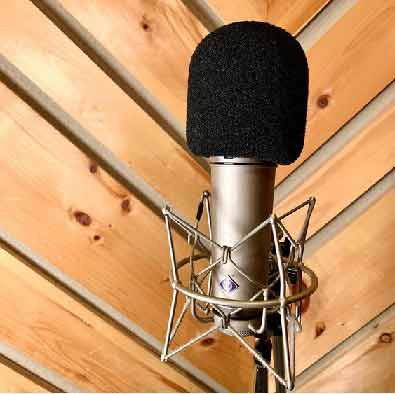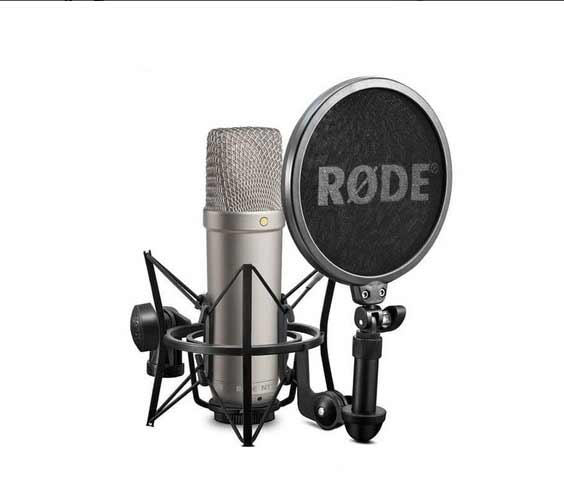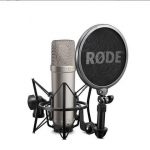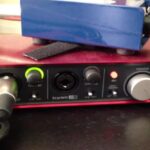When an artist wants to record a song in the studio, they will try to use the best condenser microphone. After all, who does not want their crisp, clear voices to reach the hearts of millions? The same goes for every other people in the recording industry.
In podcasts, animation voice-overs, studios everywhere use the condenser microphone to have superior sound quality. Why is this the first choice, and how does a condenser microphone work?
Today, we will find out. So, read on to learn more about it.

Table of Contents
What Is a Condenser Microphone?
While talking about the condenser microphone, we should also know about other types of microphones. Studios and artists use two microphones for audio work or recording projects: condenser microphones and Dynamic Microphones.
The dynamic microphone is used for stage performances. In contrast, the condenser microphone is used to record audio in the studio environment because instead of picking up loud, harsh noises, it takes up the more delicate, nuanced sounds.
Moreover, the condenser or capacitor is capsuled with a gold-sputtered mylar diaphragm. It is advantageous to gold-sputter a Mylar diaphragm to make it electrically conductive. This makes the diaphragm part of the condenser capsule.
The backplate of the microphone is made of solid brass with a hole pattern drilled with tremendous accuracy, which is needed for a smooth sound.
Also Read: How to connect condenser mic to Mac?
Types of Condenser Microphones
The diaphragm of a condenser microphone has a lower mass than the diaphragm of a dynamic microphone, allowing it to follow sound waves more accurately.
There are mainly two condenser microphones, depending on the specific needs. Each has a unique quality in terms of sound capture and is utilized distinctly throughout the recording. So, you have to know about your microphone before you jump to your next audio project.
Large-Diaphragm Condenser Microphones
This condenser microphone can be found in the recording booths. It should be set up in a fixed position. As the diaphragm used in this microphone is over an inch long, it usually receives audio from the side-facing position.
Their objective is to enlarge, engage, beautify, and endear the sound source. Utilize them to highlight voices and other lead instruments.
Small-Diaphragm Condenser Microphones
This microphone is more miniature, and you can use them easily in your house from the desktop or mounted position. Its diaphragm is less than an inch in size.
Small-Diaphragm Microphones’ diaphragm is in a front-facing position. These condensers provide you with an uncolored, neutral, and incredibly detailed sound picture. If you want to capture anything as it is, these are the tools for you.

How Does a Condenser Microphone Work?
The mechanism’s pretty simple. But to learn how it works, you need to know some of the basic facts:
Components of the Condenser Microphone:
The condenser microphone’s name has already given us an idea of how it works. It has a capacitor that mainly converts sound waves to electric signals. The condenser is another term used for the word capacitor.
This capacitor inside the studio condenser microphone has installed two parallel metal surfaced plates. These plates are positioned near one another with a voltage applied across their surfaces.
The plates placed in the capacitors are the back plate and the diaphragm. Firstly, the back plate is made of solid brass with a hole pattern. Another plate is the diaphragm which is made from light metal.
Sometimes this plate is coated with gold to conduct electricity more effectively. This capacitor is placed in the microphone capsule.
Receiving and Creating Audio Signal:
The diaphragm is responsible for detecting minute fluctuations in air pressure that contribute to the room’s sound, vocalist, or instrument being captured. Sound waves move the diaphragm and the back plate apart from each other.
This causes a voltage change across a capacitor. In this case, the voltage is the electrical signal, and it changes quickly to match the pattern of the original sound waves.
The signal has been created, and we are ready to listen. But, no! Before that, it needs to be amplified as the voltage between two capacitor plates generates no electricity. An external power source is required for a condenser microphone to function correctly and amplify the signal.
Amplifying the Signal:
The first method uses the 48V Phantom Power, a 48-volt signal routed straight from a preamp or audio interface to the microphone using an XLR connection. It is referred to as Phantom Power since it can transmit a power supply over the same XLR cable used to send the audio signal.
Another method is to use a vacuum tube. When recording or transmitting, a tube condenser microphone uses a vacuum tube to enhance the signal from the capsule to get optimal results.
Tube microphones require more power than the usual 48V Phantom Power to perform appropriately and therefore require an additional power source in addition to the regular 48V Phantom Power.
The third method is the usage of electret. It is a very thin film that is put on the back plate or the diaphragm. This material is a permanently charged dielectric that powers a condenser mic through an internal battery.
Also Read: MXL 770 Review
Condenser Microphone: Advantages and Disadvantages!
By far, we have discussed that a condenser microphone is one of the best microphones out there. When it comes to studio work and recording sessions where a high level of clarity and delicacy is required, condenser microphones are frequently the preferred choice.
However, they are not appropriate for every occasion.
Advantages:
- Condenser capsules capture delicate nuances and rich tones that other microphones may miss
- A condenser microphone with a free polar pattern is perfect for group recording
- Condenser microphones are ideal for capturing ambiances because of their sensitivity, broad dynamic range, and low noise floor
Disadvantages:
- Because their capsules are designed to be sensitive, powerful noises can quickly overwhelm them, causing distortion
- Adding to the loudness issue, a high-volume level can quickly destroy a condenser mic’s diaphragm
- They are also at a disadvantage when recording live sound
Also Read: How to Connect Condenser Mic to Speaker?
Is a Condenser Mic Good for Vocals?
Yes, a condenser mic is a great choice for vocals. It has a wider frequency range than a dynamic mic, which makes it better for capturing high-frequency sounds. Additionally, a condenser mic is less prone to feedback, so it is ideal for tracking vocals in a live setting. To know you can check here best affordable condenser mics for vocals.
Condenser microphone problems and solutions!
Condenser microphone problems and solutions can be a major headache, but there are a few things that you can do to alleviate the situation.
First, make sure that the microphone is plugged into an electrical outlet and that it is properly grounded.
Next, make sure that the microphone is properly aligned and that the capsules are in good condition. If the microphone is not functioning properly, it may be necessary to replace the capsules.
If the microphone is producing too much noise, it may be necessary to adjust the gain.
Lastly, if the microphone is still not functioning correctly, it may be necessary to replace the microphone.
Also Read: How to Connect a Condenser Mic to a Pc?
Condenser Microphone for Your Best Sound Experience!
Before starting your audio projects, understand what type of microphone you need. For podcasts, everyday voice-over work, or recording songs condenser microphone is hands down the best option for you.
However, make sure you know how does a condenser microphone work based on the type. By doing this, you can have the best sound quality for your work. You can see here some best condenser mic under 200.

Williams Kane is a blogger and writer. He’s passionate about writing and connecting with the community, especially when it comes to sharing his ideas through writing.
I am a versatile author with a passion for exploring a wide range of topics on our multi-niche website. With a background in research and a love for writing, I bring a unique blend of expertise to our platform.
My journey began in the world of science, where I earned a degree in biology and developed a deep fascination for the natural world. This background enables me to delve into topics related to ecology, environmental conservation, and the wonders of the animal kingdom.
However, my curiosity knows no bounds, and I have ventured into various other niches as well. From technology trends and digital innovations to health and wellness tips, I strive to provide well-researched and engaging content that informs and entertains our diverse audience.
Furthermore, my dedication to staying current with the latest developments in each niche ensures that our readers receive up-to-date and reliable information. Whether it’s deciphering complex scientific concepts or simplifying tech jargon, I take pride in making complex subjects accessible to all.
Join me on our multi-niche journey, where we explore the depths of knowledge and share insights on a multitude of topics to inspire, educate, and entertain.





